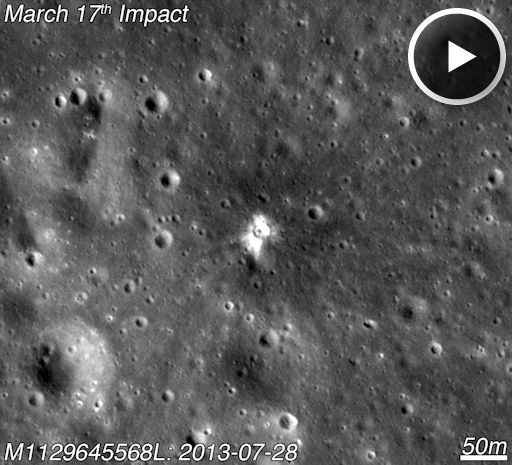QUIET SUN: The face of the sun is peppered with spots, but none of them is actively flaring. Solar activity is low on Dec. 17th. Solar flare alerts: text, voice
SUNSET SKY SHOW: When the sun goes down tonight, step outside and face east. Jupiter and the Moon are converging for a close encounter. On Tuesday, Dec. 17th, the pair fit together inside the constellation Gemini, and on Wednesday, Dec. 18th, they'll form a set of "celestial headlights" only 5 degrees apart. Take a look. It's a beautiful way to end the day. Sky maps: Dec. 17, 18.
A NEW CRATER ON THE MOON: Most craters on the Moon were formed millions or even billions of years ago. NASA's Lunar Reconnaissance Orbiter just found one, however, that is only 9 months old. On March 17, 2013, a bright flash of light emerged from Mare Imbrium, the Sea of Rains. Researchers concluded that a small asteroid about 0.2 meters wide hit the lunar surface and exploded like 1.3 tons of TNT. Here is the crater it made:
Lunar Reconnaissance Orbiter's LROC camera photographed the crater in July when the spacecraft made a routine pass over the impact site. Subsequent analyses presented at last week's American Geophysical Union meeting linked the crater to the March 17th impact. According to the LROC photo, the crater is 18 meters (59 feet) wide. Together with the bright rays of fresh ejecta ringing the central gouge, the entire impact mark spans an area of lunar terrain half the size of an American football field.
Unlike Earth, which has an atmosphere to protect it, the airless Moon is baldly exposed to incoming asteroids. NASA's Meteoroid Environment Office monitors the lunar surface for signs of ongoing impacts. Since 2005 they have detected flashes of light from more than 300 explosions. The March 17th event was the brightest they'd ever seen, 10 times more luminous than any other lunar meteor in the history of the program. LROC's detection of a crater in Mare Imbrium provides the kind of "ground truth" measurement they need to calibrate the entire dataset.
Realtime Space Weather Photo Gallery
THE LONG TAIL OF COMET LOVEJOY: Next week, Comet Lovejoy makes its closest approach to the sun. The comet's tail is already amazing. Scroll down this image taken by Gerald Rhemann of Jauerling, Austria, for more information:
Filled with knots and eddies of dusty plasma, Lovejoy's tails stretches more than 20 degrees across the sky--long enough to overlap 40 full Moons or fill the Bowl of the Big Dipper twice. At closest approach to the sun or "perihelion" on Dec. 23rd, the comet will be just inside the orbit of Earth (0.82 AU). The extra heating it gets at perihelion will grow the tail even more.
Comet Lovejoy shines like a 4th magnitude star so it is barely visible to the unaided eye (especialy when the sky is filled with full moonlight). However, for backyard telescopes, the comet is a fairly easy target rising ahead of the sun in the eastern morning sky. If you have a GOTO telescope, send it to these coordinates. Slight pointing errors are no problem, because the tail is almost impossible to miss.

Solar wind
speed: 399.2 km/sec
density: 2.0 protons/cm3
explanation | more data
Updated: Today at 1716 UT
X-ray Solar Flares
6-hr max: C1 1532 UT Dec17
24-hr: C1 1532 UT Dec17
explanation | more data
Updated: Today at: 1653 UT
![]()
Daily Sun: 17 Dec 13
Sunspot AR1917 has a 'beta-gamma' magnetic field that harbors energy for M-class solar flares. Credit: SDO/HMI
![]()
Sunspot number: 114
What is the sunspot number?
Updated 17 Dec 2013
Spotless Days
Current Stretch: 0 days
2013 total: 0 days (0%)
2012 total: 0 days (0%)
2011 total: 2 days (<1%)
2010 total: 51 days (14%)
2009 total: 260 days (71%)
Since 2004: 821 days
Typical Solar Min: 486 days
Update 17 Dec 2013
The Radio Sun
10.7 cm flux: 154 sfu
explanation | more data
Updated 17 Dec 2013
![]()
Current Auroral Oval:
Switch to: Europe, USA, New Zealand, Antarctica
Credit: NOAA/POES
![]()
Planetary K-index
Now: Kp= 0 quiet
24-hr max: Kp= 1 quiet
explanation | more data
Interplanetary Mag. Field
Btotal: 4.0 nT
Bz: 3.3 nT south
explanation | more data
Updated: Today at 1652 UT
![]()
Coronal Holes: 16 Dec 13
There are no large coronal holes on the Earthside of the sun. Credit: SDO/AIA.






